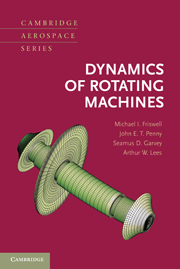Book contents
- Frontmatter
- Contents
- Preface
- Acronyms
- 1 Introduction
- 2 Introduction to Vibration Analysis
- 3 Free Lateral Response of Simple Rotor Models
- 4 Finite Element Modeling
- 5 Free Lateral Response of Complex Systems
- 6 Forced Lateral Response and Critical Speeds
- 7 Asymmetric Rotors and Other Sources of Instability
- 8 Balancing
- 9 Axial and Torsional Vibration
- 10 More Complex Rotordynamic Models
- Solutions to Problems
- Appendix 1 Properties of Solids
- Appendix 2 Stiffness and Mass Coefficients for Certain Beam Systems
- Appendix 3 Torsional Constants for Shaft Sections
- Bibliography
- Index
1 - Introduction
Published online by Cambridge University Press: 05 February 2015
- Frontmatter
- Contents
- Preface
- Acronyms
- 1 Introduction
- 2 Introduction to Vibration Analysis
- 3 Free Lateral Response of Simple Rotor Models
- 4 Finite Element Modeling
- 5 Free Lateral Response of Complex Systems
- 6 Forced Lateral Response and Critical Speeds
- 7 Asymmetric Rotors and Other Sources of Instability
- 8 Balancing
- 9 Axial and Torsional Vibration
- 10 More Complex Rotordynamic Models
- Solutions to Problems
- Appendix 1 Properties of Solids
- Appendix 2 Stiffness and Mass Coefficients for Certain Beam Systems
- Appendix 3 Torsional Constants for Shaft Sections
- Bibliography
- Index
Summary
Overview
The aim of this book is to introduce readers to modern methods of modeling and analyzing rotating machines to determine their dynamic behavior. This is usually referred to as rotordynamics. The text is suitable for final-year undergraduates, postgraduates, and practicing engineers who require both an understanding of modern techniques used to model and analyze rotating systems and an ability to interpret the results of such analyses.
Before presenting a text on the dynamics of rotating machines, it is appropriate to consider why one would wish to study this subject. Apart from academic interest, it is an important practical subject in industry, despite the forbidding appearance of some of the mathematics used. There are two important application areas for the techniques found in the following pages. First, when designing the rotating parts of a machine, it is clearly necessary to consider their dynamic characteristics. It is crucial that the design of a machine is such that while running up to and functioning at its operating speed(s), vibration does not exceed safe and acceptable levels. An unacceptably high level of rotor vibration can cause excessive wear on bearings and may cause seals to fail. Blades on a rotor may come into contact with the stationary housing with disastrous results. An unacceptable level of vibration might be transmitted to the supporting structure and high levels of vibration could generate an excessive noise level. The second aspect of importance is the understanding of a machine's behavior when circumstances change, implying that a fault has occurred in the rotating parts of the machine.
Information
- Type
- Chapter
- Information
- Dynamics of Rotating Machines , pp. 1 - 16Publisher: Cambridge University PressPrint publication year: 2010
Accessibility standard: Unknown
Why this information is here
This section outlines the accessibility features of this content - including support for screen readers, full keyboard navigation and high-contrast display options. This may not be relevant for you.Accessibility Information
- 1
- Cited by
